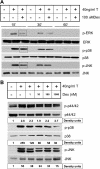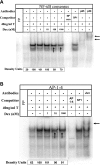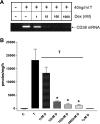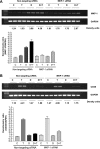Glucocorticoid regulation of CD38 expression in human airway smooth muscle cells: role of dual specificity phosphatase 1
- PMID: 18441094
- PMCID: PMC2494782
- DOI: 10.1152/ajplung.00352.2007
Glucocorticoid regulation of CD38 expression in human airway smooth muscle cells: role of dual specificity phosphatase 1
Abstract
The enzymatic activity of CD38, ADP-ribosyl cyclase, synthesizes the calcium mobilizing molecule cyclic ADP-ribose from beta-NAD. In human airway smooth muscle (HASM) cells, CD38 expression is augmented by the inflammatory cytokine, TNF-alpha, causing increased intracellular calcium response to agonists. The transcriptional and posttranscriptional regulation of CD38 expression involves signaling through MAPKs and requires activation of NF-kappaB and activator protein-1 (AP-1). The cytokine-augmented CD38 expression is decreased by anti-inflammatory glucocorticoids due to inhibition of NF-kappaB activation and other mechanisms. In this study, we investigated glucocorticoid regulation of CD38 expression in HASM cells through the MKP-1. In HASM cells, dexamethasone and TNF-alpha induced MKP-1 expression (both mRNA and protein) rapidly. Dexamethasone decreased TNF-alpha-induced phosphorylation of the major MAPKs, i.e., ERK, p38, and JNK, and decreased the activation of NF-kappaB and AP-1. Dexamethasone also decreased CD38 expression induced by TNF-alpha, and part of this effect was attributable to decreased transcript stability. In cells transfected with MKP-1-specific small interfering RNAs (siRNAs), there was significant attenuation of MKP-1 expression and partial, but nonsignificant, reversal of dexamethasone inhibition of CD38 expression. These results indicate that regulation of CD38 expression in HASM cells by glucocorticoids involves decreased signaling through MAPKs and activation of transcription factors. The glucocorticoid effects on decreased CD38 expression and function result from regulation through transcription and transcript stability.
Figures






Similar articles
-
CD38 and airway hyper-responsiveness: studies on human airway smooth muscle cells and mouse models.Can J Physiol Pharmacol. 2015 Feb;93(2):145-53. doi: 10.1139/cjpp-2014-0410. Epub 2014 Dec 9. Can J Physiol Pharmacol. 2015. PMID: 25594684 Free PMC article. Review.
-
TNF-alpha induced CD38 expression in human airway smooth muscle cells: role of MAP kinases and transcription factors NF-kappaB and AP-1.Am J Physiol Lung Cell Mol Physiol. 2007 Jun;292(6):L1385-95. doi: 10.1152/ajplung.00472.2006. Epub 2007 Feb 23. Am J Physiol Lung Cell Mol Physiol. 2007. PMID: 17322278
-
Regulation of the cd38 promoter in human airway smooth muscle cells by TNF-alpha and dexamethasone.Respir Res. 2008 Mar 14;9(1):26. doi: 10.1186/1465-9921-9-26. Respir Res. 2008. PMID: 18341691 Free PMC article.
-
Transcriptional regulation of CD38 expression by tumor necrosis factor-alpha in human airway smooth muscle cells: role of NF-kappaB and sensitivity to glucocorticoids.FASEB J. 2006 May;20(7):1000-2. doi: 10.1096/fj.05-4585fje. Epub 2006 Mar 29. FASEB J. 2006. PMID: 16571778
-
CD38/cADPR Signaling Pathway in Airway Disease: Regulatory Mechanisms.Mediators Inflamm. 2018 Feb 7;2018:8942042. doi: 10.1155/2018/8942042. eCollection 2018. Mediators Inflamm. 2018. PMID: 29576747 Free PMC article. Review.
Cited by
-
Glucocorticoid and TNF signaling converge at A20 (TNFAIP3) to repress airway smooth muscle cytokine expression.Am J Physiol Lung Cell Mol Physiol. 2016 Aug 1;311(2):L421-32. doi: 10.1152/ajplung.00179.2016. Epub 2016 Jul 1. Am J Physiol Lung Cell Mol Physiol. 2016. PMID: 27371733 Free PMC article.
-
Dual-specificity phosphatase 1 as a pharmacogenetic modifier of inhaled steroid response among asthmatic patients.J Allergy Clin Immunol. 2010 Sep;126(3):618-25.e1-2. doi: 10.1016/j.jaci.2010.06.007. Epub 2010 Jul 31. J Allergy Clin Immunol. 2010. PMID: 20673984 Free PMC article. Clinical Trial.
-
CD38 and airway hyper-responsiveness: studies on human airway smooth muscle cells and mouse models.Can J Physiol Pharmacol. 2015 Feb;93(2):145-53. doi: 10.1139/cjpp-2014-0410. Epub 2014 Dec 9. Can J Physiol Pharmacol. 2015. PMID: 25594684 Free PMC article. Review.
-
Th2 cytokine-induced upregulation of 11beta-hydroxysteroid dehydrogenase-1 facilitates glucocorticoid suppression of proasthmatic airway smooth muscle function.Am J Physiol Lung Cell Mol Physiol. 2009 May;296(5):L790-803. doi: 10.1152/ajplung.90572.2008. Epub 2009 Feb 27. Am J Physiol Lung Cell Mol Physiol. 2009. PMID: 19251840 Free PMC article.
-
Understanding how long-acting β2 -adrenoceptor agonists enhance the clinical efficacy of inhaled corticosteroids in asthma - an update.Br J Pharmacol. 2016 Dec;173(24):3405-3430. doi: 10.1111/bph.13628. Epub 2016 Nov 9. Br J Pharmacol. 2016. PMID: 27646470 Free PMC article. Review.
References
Publication types
MeSH terms
Substances
Grants and funding
LinkOut - more resources
Full Text Sources
Medical
Research Materials
Miscellaneous

